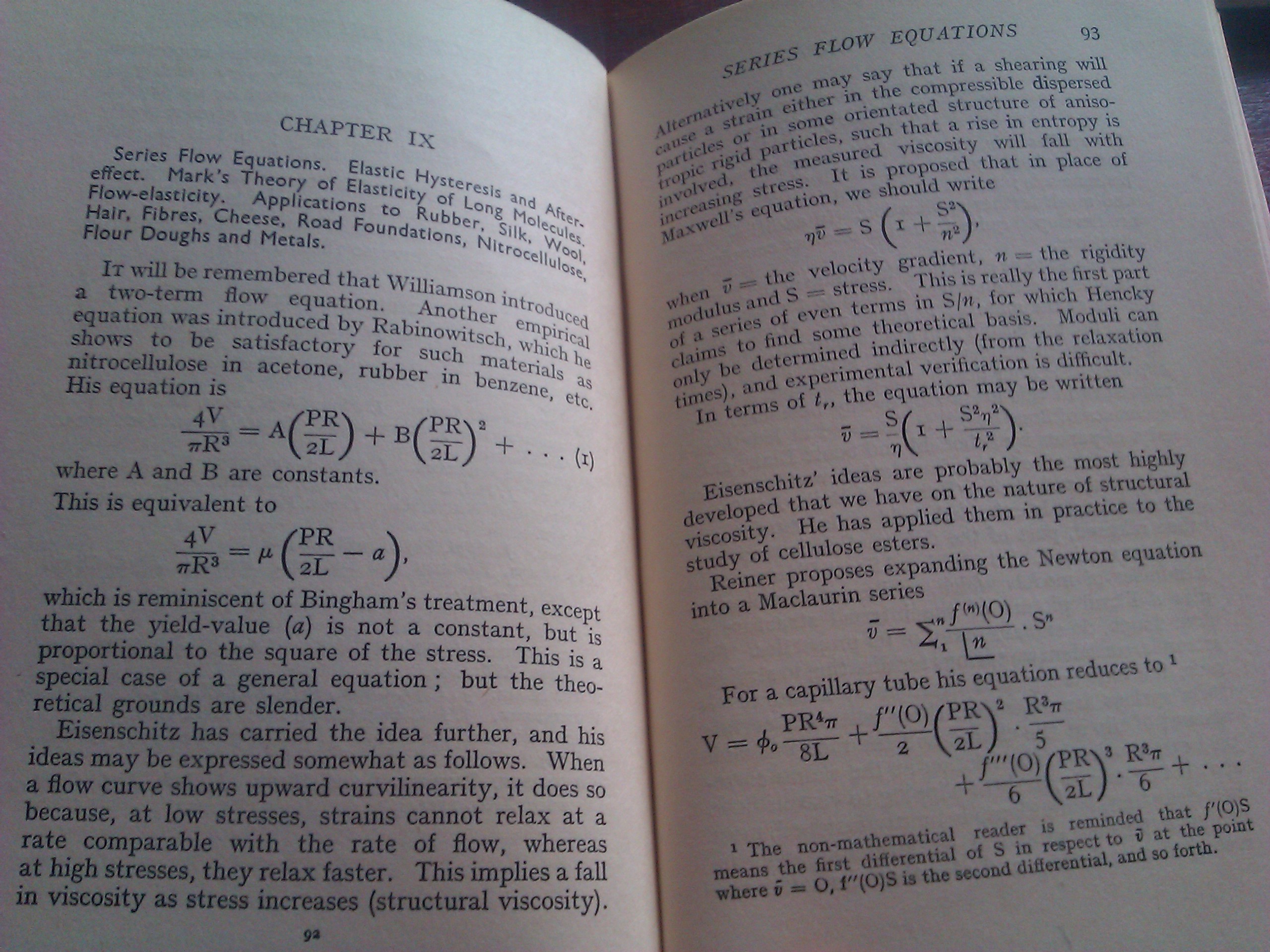str (93)

CHAPTER IX

It will be remembered that Williamson introduced a two-term flow eąuation. Another empirical eąuation was introduced by Rabinowitsch, whichhe shows to be satisfactory for such materials as nitrocellulose in acetone, rubber in benzene, etc. His eąuation is

where A and B are constants. This is equivalent to

which is reminiscent of Bingham's treatment, except that the yield-value (a) is not a constant, but is proportional to the sąuare of the stress. This is a special case of a generał eąuation; but the theo-retical grounds are slender.
Eisenschitz has carried the idea further, and his ideas may be expressed somewhat as follows. When a flow curve shows upward curvilinearity, it does so because, at Iow stresses, strains cannot relax at a ratę comparable with the ratę of flow, whereas at high stresses, they relax faster. This implies a fali in viscosity as stress increases (structural viscosity).
9*
\lternatively one may say that it a shearing vnh se a strain either in the compressible dispersed Hrticles or in some orientated structure ot aniso-tropie rigid partid.es, such that a rise in entropy is involved, the measured viscosity witt tah vńth increasing stress. It is proposcd that in place ot Maxwell's eąuation, we should write
T)V = S

when v — the velocity gradient, n -- the rigidity modulus and S — stress. This is really the lirst part ot 1 series of even terms in S/rt, for which Hencky cl.tiras to fmd some theoretical basis. Moduli can only be dctcrmined indirectiy (from the relaxation times), and experimental yerification is difficuit.
In terms of tr, the eąuation may be written

Eisenschitz’ ideas are probably the most highly developed that we have on the naturę of structural viscosity. He has applied them in practice to the study of cellulose esters.
Reiner proposes expanding the Newton eąuation into a Maclaurin series

For a capillary tubę his eąuation reduces to 1
pR%+no) i

| The non-mathcmatical reader is reminded that /'(0)S means the first differential of S in respect to 5 at the point wbere v — O, f"(0)S is the second diflerential, and so forth.
Wyszukiwarka
Podobne podstrony:
cbook06 be save& If, figurea; group by a 9. It will be found that considerable l&bour w
mode-conversion coefficients, and it will be shown that the spatial wave-number spectrum of the loca
3* Ropę-iS tg ht. It will be notieed that, aft er doing the duty required at one lead-end, the cours
Future Perfect Progressive rttrl to emphasize or show that it will be a long time fule ; = to emphas
Comparison ofLiguid Pr opel font Rocket Engine Feed Systems - 1 - 14 For each calculation routine, i
2 System introduction Objectives After this chapter the student will: • be able to
cp 59 TRY TO WALK FIRST N starting my mcthod of correct posturę, it will be well worth while to firs
10 silver?lls Siiver Belis Ting-a-ling. Hear them rin3? Soon it will be Chnstmas Day.Herc is what yo
FOOTBALL 1914 The football season of 1914 will be remembered in tbe history of Salem High School in
Melissa Estrada Chavez It will be as Ifl never existed
img023 4 242 NEC.UGENCE: CAUSATION AND CONTR1BUTORY NECLIGENCE it must be shown that there is someth
PROGRAM ROZWOJOWY^1 POLITECHNIKI WARSZAWSKIEJ It should be noticed that the interval of conduction i
PROGRAM ROZWOJOWY^1 POLITECHNIKI WARSZAWSKIEJ It should be noticed that the interval of conduction i
Acta Polytechnica Hungarica Vol. 5, No. 4,2008 It can be seen that teaching this subject draws 4 yea
więcej podobnych podstron